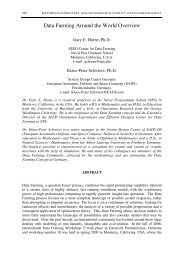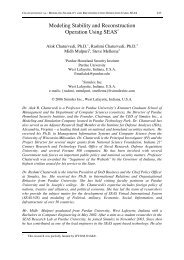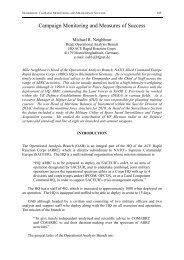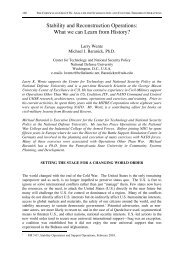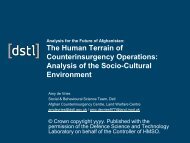The British Army's Effectiveness in the Irish ... - Cornwallis Group
The British Army's Effectiveness in the Irish ... - Cornwallis Group
The British Army's Effectiveness in the Irish ... - Cornwallis Group
Create successful ePaper yourself
Turn your PDF publications into a flip-book with our unique Google optimized e-Paper software.
100 THE CORNWALLIS GROUP XIV: ANALYSIS OF SOCIETAL CONFLICT AND COUNTER-INSURGENCY<br />
LESSONS FOR COUNTERINSURGENCY CAMPAIGNS<br />
For over 50 years follow<strong>in</strong>g <strong>the</strong> events described, <strong>the</strong> <strong>Irish</strong> War of Independence was<br />
forgotten everywhere, except <strong>in</strong> Ireland. In <strong>the</strong> period between <strong>the</strong> World Wars when Brita<strong>in</strong><br />
was formalis<strong>in</strong>g its counter-<strong>in</strong>surgence doctr<strong>in</strong>e, Ireland was ‘airbrushed’ from official<br />
histories. 40 Black and Tan style polic<strong>in</strong>g policies (and some of <strong>the</strong> personnel) would reappear<br />
<strong>in</strong> Palest<strong>in</strong>e, a campaign that ended <strong>in</strong> 1948 with an ignom<strong>in</strong>ious exit even worse than<br />
Ireland. 41 <strong>The</strong>re has been a clear failure by <strong>the</strong> <strong>British</strong> to learn lessons from Ireland. 42 <strong>The</strong><br />
major studies that were carried out, e.g. divisional histories by 5 and 6 Divisions and two<br />
volumes from Army HQ <strong>in</strong> Dubl<strong>in</strong>, are available through personal collections deposited <strong>in</strong><br />
<strong>the</strong> Imperial War Museum, not <strong>the</strong> National Archives where official records are expected to<br />
be held. 43<br />
Despite <strong>the</strong> apparent lack of <strong>in</strong>terest by <strong>the</strong> <strong>British</strong> military to learn lessons from Ireland,<br />
a number of commentators have attempted to summarize <strong>the</strong> pr<strong>in</strong>cipal lessons. 44 Apart from<br />
<strong>the</strong> obvious ones about hav<strong>in</strong>g a unified and coherent policy, not seek<strong>in</strong>g quick-fixes and not<br />
underestimat<strong>in</strong>g <strong>the</strong> enemy, <strong>the</strong> pr<strong>in</strong>cipal lessons that can be identified from <strong>the</strong> <strong>Irish</strong><br />
Campaign are <strong>the</strong> follow<strong>in</strong>g:<br />
• <strong>The</strong> need to have a unified <strong>in</strong>telligence system, particularly between civil and<br />
military authorities.<br />
• <strong>The</strong> need to target <strong>the</strong> most radical elements, <strong>in</strong>clud<strong>in</strong>g <strong>the</strong> use of less coercive<br />
methods aga<strong>in</strong>st moderates.<br />
• <strong>The</strong> avoidance of tit-for-tat violence and terror measures.<br />
• <strong>The</strong> need to consider effects on <strong>the</strong> wider stage i.e. propaganda.<br />
• Rapid and secure communications.<br />
• <strong>The</strong> need to deal promptly with security breaches and to protect sources, i.e.<br />
an active counter-<strong>in</strong>telligence and security capability.<br />
40 Charles J Gwynn, Imperial Polic<strong>in</strong>g (London: MacMillan and Company, 1939). <strong>The</strong> only reference Gwynn<br />
makes to Ireland is to <strong>the</strong> usefulness of study<strong>in</strong>g books such as With <strong>the</strong> Dubl<strong>in</strong> Brigade, but he is referr<strong>in</strong>g<br />
to <strong>the</strong> Dubl<strong>in</strong> Brigade of <strong>the</strong> IRA, not <strong>the</strong> <strong>British</strong> Army.<br />
41 Charles Townshend, ‘In Aid of <strong>the</strong> Civil Power: Brita<strong>in</strong>, Ireland and Palest<strong>in</strong>e 1916-1948’ <strong>in</strong><br />
Counter<strong>in</strong>surgency <strong>in</strong> Modern Warfare, edited by Daniel Marston and Carter Malkasian (Oxford: Osprey<br />
Publish<strong>in</strong>g, 2008), 19-36.<br />
42 This can easily be seen <strong>in</strong> Nor<strong>the</strong>rn Ireland after <strong>the</strong> outbreak of violence <strong>in</strong> 1969. It took a fur<strong>the</strong>r 15 years<br />
before an <strong>in</strong>tegrated police and army <strong>in</strong>telligence organisation was formed.<br />
43 <strong>The</strong> 5 th Division history and <strong>the</strong> GHQ histories of Operations (Vol 1) and Intelligence (Vol 2) are <strong>in</strong> <strong>the</strong><br />
private records of Lieutenant-General Sir Hugh Jeudw<strong>in</strong>e. <strong>The</strong> 6 th Division history is <strong>in</strong> <strong>the</strong> private records<br />
of Lieutenant-General Sir Peter Strickland.<br />
44 Col<strong>in</strong> S Gray, ‘<strong>The</strong> Anglo-<strong>Irish</strong> War 1919-21: Lessons from an Irregular Conflict’, Comparative Strategy<br />
26, No. 5 (2007): 371-394. Gray gives 28 lessons. Ano<strong>the</strong>r study which compares <strong>British</strong> effectiveness<br />
aga<strong>in</strong>st US OOTW doctr<strong>in</strong>e is Michael R Fierro, <strong>British</strong> Counter<strong>in</strong>surgency Operations <strong>in</strong> Ireland 1916-<br />
1921: A Case Study (Newport RI: Naval War College, 1997).



